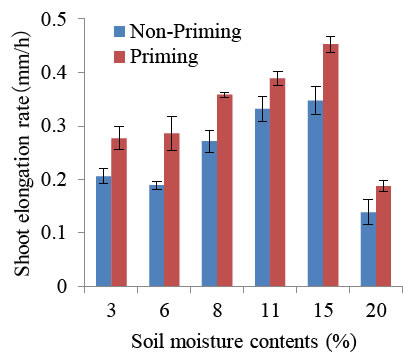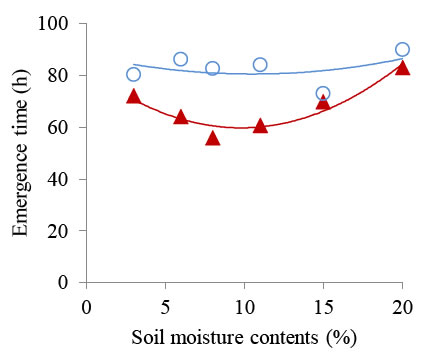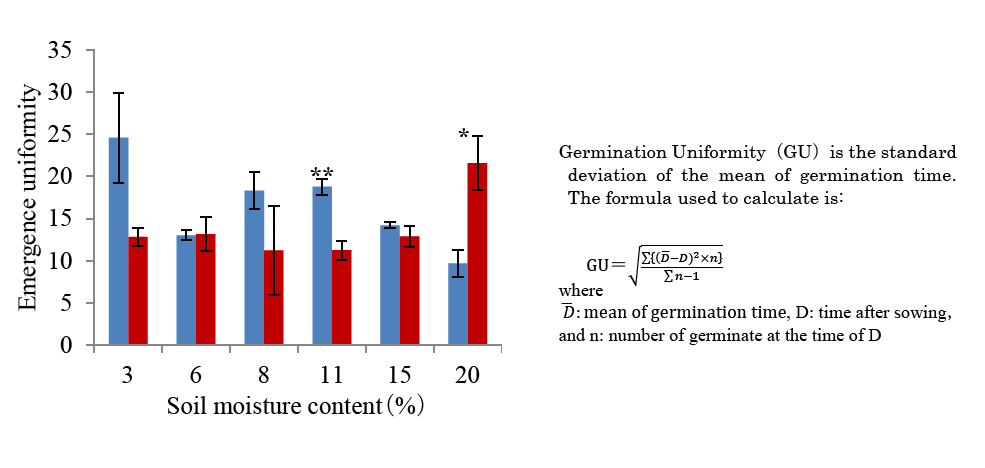Rice seed priming improves germination speed, germination uniformity, and seedling emergence
Description
Improving seedling establishment and emergence rates is extremely important in the development of a direct seeding rice cultivation technology and for maintaining sustainable production for the rainfed lowlands of Africa. However, individual differences in initial growth rates due to variations in seedling emergence affect the dry matter production and light-receiving posture of rice. These defective conditions decrease rice yield. Strategies involving techniques for good seedling establishment in a wide range of soil moisture condition are thus required because controlling soil moisture at the time of seeding is difficult, particularly in rainfed lowlands. Seed priming, a treatment method that allows artificial germination to proceed by soaking the seeds in water over a certain period and drying them back to their initial weight, has demonstrated that germination and emergence rates are accelerated and that seedling vigor is enhanced. If this technology becomes applicable to rainfed lowlands, it can contribute greatly to the establishment and expansion of a stable rice production system.
Shortened germination time was more pronounced when seeds were soaked at 24h and 48h at 20 °C water temperature, and at 12h at 30 °C. Soaking the seeds for 12h at 30 °C water temperature (similar to African conditions) reduced germination time by about 18 hours compared with non-priming (Table 1). With priming, shoot elongation rates after germination improved 1.2 times in sandy soils with moisture content from 3 to 20% (field capacity = 22.2%) inside growth chambers (Figure 1). Emergence time, meanwhile, was shortest at 8% soil moisture content, equivalent to dry conditions (Figure 2). Emergence uniformity was also improved by seed priming except at soil moisture contents equal to 6% and 20% (Figure 3). These results indicate that emergence speed is improved and stabilized by increasing the growth rate of the seedlings and thus accelerating germination.
Seed priming is practical because it can be accomplished by simply soaking and re-drying the rice seeds, eliminating the need for dedicated facilities. In conclusion, this study has shown that stabilization of emergence with fast germination rates can be obtained in the rainfed lowlands of Africa, and that primed seeds can be stored for several months as they have already been pre-soaked.
Figure, table
-
Table 1. Germination time (h) after seed priming at varying temperatures and soaking time
The time to achieve 50% germination is germination time. "-" in the tables indicates less than 50% germination. Mean±SE. **,*: Significantly different at P<0.01, 0.05(T-test). After soaking at several temperatures and at multiple time points, the seeds were dried back to attain initial seed weight before submerging in water at 25 ℃. Germination was investigated below 30 ℃ under dark conditions.
-
Figure 1. Effect of seed priming on shoot elongation rate
**,*: Significantly different at P<0.01, 0.05 (T-test) -
Figure.2 Shortened emergence time caused by seed priming
Non-priming:○, y = 0.066x2 - 1.385x + 87.814, r=0.395
Priming:▲ y = 0.237x2 - 4.630x + 82.442, r=0.957* -
Figure 3. Effect of seed priming on germination uniformity (formula shown at right)
※Emergence is uniform when‘priming’ value is lower
- Affiliation
-
Japan International Research Center for Agricultural Sciences Crop, Livestock and Environment Division
- Classification
-
Administration B
- Research project
- Program name
- Term of research
-
FY 2013 (FY 2011-FY 2015)
- Responsible researcher
-
Matsushima Kenichi ( Crop, Livestock and Environment Division )
Sakagami Junichi ( Crop, Livestock and Environment Division )
- ほか
- Publication, etc.
-
https://doi.org/10.4236/ajps.2013.48191
Matsushima, K. et al. (2013) American Journal of Plant Sciences, 4: 1584-1593
- Japanese PDF
-
2013_B04_A3_ja.pdf221.47 KB
2013_B04_A4_ja.pdf397.26 KB
- English PDF
-
2013_B04_A3_en.pdf187.2 KB
2013_B04_A4_en.pdf266.42 KB
- Poster PDF
-
2013_B04_poster.pdf1.45 MB




